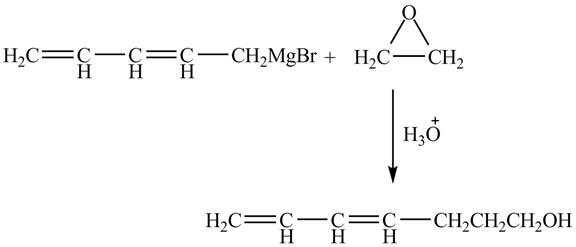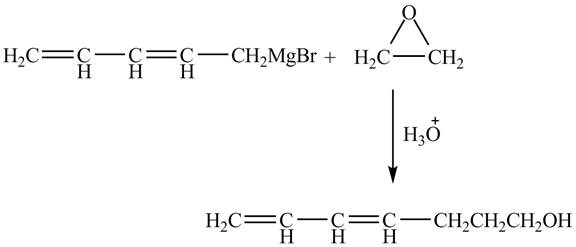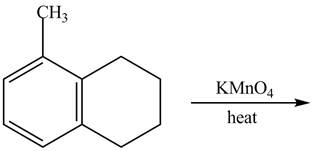
(a)
Interpretation:
The reaction in which
Concept introduction:
Grignard reagents are
Answer to Problem 17.45AP
The complete reaction between
![]()
Explanation of Solution
The given reaction is shown below.
![]()
Figure 1
The complete reaction is shown below.
![]()
Figure 2
The hydrolysis of Grignard reagent is shown in Figure 2 in the presence of a solvent
Therefore, the product formed is shown in Figure 2.
The complete reaction between
(b)
Interpretation:
The reaction between
Concept introduction:
Grignard reagents are organometallic compounds which are prepared using alkyl halides in the presence of magnesium metal in dry ether. These reagents act as strong nucleophiles and bases.
Answer to Problem 17.45AP
The complete reaction between

Explanation of Solution
The given reaction is shown below.

Figure 3
The complete reaction is shown below.

Figure 4
The Grignard reagent on treatment with epoxides in the presence of
Therefore, the product formed is shown in Figure 4.
The complete reaction between
(c)
Interpretation:
The reaction between
Concept introduction:
Nucleophiles are electron-rich species. The nucleophilic substitution reactions are the reactions in which nucleophile attacks the electrophilic center and eliminates another group.
Answer to Problem 17.45AP
The complete reaction between

Explanation of Solution
The given reaction is shown below.
![]()
Figure 5
The complete reaction is shown below.

Figure 6
The above figure shows the reaction between ethyl sulfide ion and
The complete reaction between
(d)
Interpretation:
The reaction between
Concept introduction:
Nucleophiles are electron-rich species. The nucleophilic substitution reactions are the reactions in which nucleophile attacks the electrophilic center and eliminates another group.
Answer to Problem 17.45AP
The complete reaction between

Explanation of Solution
The given reaction is shown below.

Figure 7
The complete reaction is shown below.

Figure 8
Figure 8 shows the reaction between
The complete reaction between
(e)
Interpretation:
The reaction of a given compound with NBS is to be completed.
Concept introduction:
Cyclic alkenes on reaction with N-Bromosuccinimide (NBS) forms allyl bromide, that is, bromine is substituted at the allylic position. NBS is a rich source of free radical of
Answer to Problem 17.45AP
The complete reaction of a given compound with NBS is shown below.

Explanation of Solution
The given reaction is shown below.

Figure 9
The complete reaction is shown below.

Figure 10
The NBS is used for allylic bromination that is it substitutes
Therefore, the products formed are shown in Figure 10.
The complete reaction of given compound with NBS is shown in Figure 10.
(f)
Interpretation:
The reaction between
Concept introduction:
Cyclic alkenes on reaction with N-Bromosuccinimide (NBS) forms allyl bromide, that is, bromine is substituted at the allylic position. NBS is a rich source of free radical of
Answer to Problem 17.45AP
The complete reaction between

Explanation of Solution
The given reaction is shown below.

Figure 11
The complete reaction is shown below.

Figure 12
The molecular formula of the product is
Due to the addition of NBS, benzylic bromination of
Therefore, the product formed is shown in Figure 12.
The complete reaction between
(g)
Interpretation:
The complete reaction in which
Concept introduction:
The elimination reaction of alkyl halide,
Answer to Problem 17.45AP
The complete reaction in which

Explanation of Solution
The given reaction is shown below.

Figure 13
The complete reaction is shown below.

Figure 14
The addition of
Therefore, the product formed is shown in Figure 14.
The complete reaction in which
(h)
Interpretation:
The reaction between
Concept introduction:
When an alkene reacts with water in the acidic medium the reaction follows Markovnikov rule which states that the negative part of the reagent attacks the carbon with the least number of hydrogen atoms attached to it.
Answer to Problem 17.45AP
The complete reaction between

Explanation of Solution
The given reaction is shown below.

Figure 15
The complete reaction is shown below.

Figure 16
The compound,
Therefore, the products formed are shown in Figure 16.
The complete reaction between
(i)
Interpretation:
The reaction between
Concept introduction:
The substance which gets easily reduced is termed as a strong oxidizing agent. It is also defined as the substances which oxidize other substances by accepting their electrons. Examples of strong oxidizing agents are potassium permanganate, hydrogen peroxide and many more.
Answer to Problem 17.45AP
The complete reaction between

Explanation of Solution
The given reaction is shown below.

Figure 17
The complete reaction is shown below.

Figure 18
The compound,
Therefore, the product formed is shown in Figure 18.
The complete reaction between
Want to see more full solutions like this?
Chapter 17 Solutions
ORGANIC CHEMISTRY SAPLING ACCESS + ETEX
- Show how to convert ethyl benzene to (a) 2,5-dichlorobenzoic acid and (b) 2,4-dichlorobenzoic acid.arrow_forwardHelp me solve this problem. Thank you in advance.arrow_forward22.7 Predict the monoalkylated products of the following reactions with benzene. (a) AlCl3 Ya (b) AlCl3 (c) H3PO4 (d) 22.8 Think-Pair-Share AICI3 The reaction below is a common electrophilic aromatic substitution. SO3 H₂SO4 SO₂H (a) Draw the reaction mechanism for this reaction using HSO,+ as the electrophile. (b) Sketch the reaction coordinate diagram, where the product is lower in energy than the starting reactant. (c) Which step in the reaction mechanism is highest in energy? Explain. (d) Which of the following reaction conditions could be used in an electrophilic aro- matic substitution with benzene to provide substituted phenyl derivatives? (i) AICI3 HNO3 H₂SO4 K2Cr2O7 (iii) H₂SO4 (iv) H₂PO₁arrow_forward
- Is an acid-base reaction the only type of reaction that would cause leavening products to rise?arrow_forwardHelp me understand this! Thank you in advance.arrow_forward22.22 For each compound, indicate which group on the ring is more strongly activating and then draw a structural formula of the major product formed by nitration of the compound. Br CHO (a) CH3 (b) (c) CHO CH3 SO₂H (d) ☑ OCHS NO₂ (e) (f) CO₂H NHCOCH3 NHCOCH, (h) CHS 22.23 The following molecules each contain two aromatic rings. (b) 000-100- H3C (a) (c) Which ring in each undergoes electrophilic aromatic substitution more readily? Draw the major product formed on nitration.arrow_forward
- V Consider this step in a radical reaction: Br: ? What type of step is this? Check all that apply. Draw the products of the step on the right-hand side of the drawing area below. If more than one set of products is possible, draw any set. Also, draw the mechanism arrows on the left-hand side of the drawing area to show how this happens. ⚫ionization termination initialization neutralization none of the abc Explanation Check 80 Ο F3 F1 F2 2 F4 01 % do5 $ 94 #3 X 5 C MacBook Air 25 F5 F6 66 ©2025 ˇ F7 29 & 7 8arrow_forwardShow how to convert ethyl benzene to (a) 2,5-dichlorobenzoic acid and (b) 2,4-dichlorobenzoic acid.arrow_forwardno aiarrow_forward
- Polymers may be composed of thousands of monomers. Draw three repeat units (trimer) of the polymer formed in this reaction. Assume there are hydrogen atoms there are hydrogen atoms on the two ends of the trimer. Ignore inorganic byproducts.arrow_forwardDraw a tetramer if this alternating copolymer pleasearrow_forwardDraw the monomers required to synthesize this condensation polymer.arrow_forward
 Organic Chemistry: A Guided InquiryChemistryISBN:9780618974122Author:Andrei StraumanisPublisher:Cengage Learning
Organic Chemistry: A Guided InquiryChemistryISBN:9780618974122Author:Andrei StraumanisPublisher:Cengage Learning
